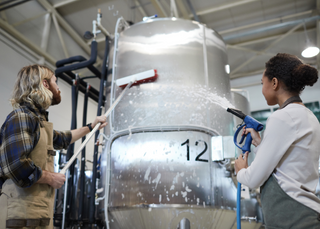Extreme Cold - How to Keep Workers Safe
Posted by Clarion Safety Systems | 1st Dec 2021

Limiting
Outdoor Exposure
Working in outdoor construction in the
winter months can cause various adverse effects on the human body and its
ability to perform, as well as increase the risk of common hazards and
cold-associated injuries. To maintain healthy temperatures in colder
environments, the body is required to work harder, but when temperatures drop
drastically and wind chill increases, heat
is apt to leave the body more rapidly. The ability to quickly recognize
the symptoms of cold stress is important for preventing cold-related injuries.
According to OSHA, cold stress occurs by driving down the skin temperature and
eventually the internal body temperature, or core temperature. Common risk
factors for cold stress include but are not limited to wetness/dampness, dressing
improperly, exhaustion, and poor physical conditioning. Cold stress can often
lead to serious illness, permanent nervous system damage, or even death.
This is why it’s so important for employers to limit worker’s exposure to the cold as much as possible, much of which can be done through proper administrative and engineering controls. Employers should provide a heated area such as a trailer or tent to take frequent breaks and warm up, as well as encourage workers to change wet clothes and drink warm beverages in the heated area. Break time is the perfect opportunity to check for signs of frostbite, hypothermia, or other markers of cold stress. Additional administrative measures that employers can take for outdoor construction job sites are as follows:
- Shielding workers from drafts and wind with plastic sheeting and tarps.
- Training supervisors and workers more thoroughly on the risks and warning signs of cold stress, along with prevention methods.
- Acclimatizing new workers and those returning after time away from work by gradually increasing their workload, and allowing more frequent breaks in warm areas, as they build up a tolerance for working in the cold environment.
- Adjusting schedules according to OSHA- and NWS-recommended time limits and the warmest parts of the day. This includes reworking non-critical maintenance tasks to be completed in warmer months.
- Requiring workers to use the buddy system while outdoors.
- Supplying warm portable toilets, as some workers may avoid drinking adequate amounts of water if they don’t want to hike to a cold toilet.
- Setting up regular supply checks to ensure you’re always well-stocked on salt, shovels, gas, road flares, tow chains, and more.
Dressing For the Occasion – Layer Up
A main preventative measure of cold stress is dressing appropriately for the
weather conditions. As an employer there is no OSHA requirement to provide
workers with ordinary clothing or other items used solely for protection of
weather, although it’s a good idea to either take the initiative to provide
these, or at least inform employees of the best winter weather gear to equip
with. When low temperatures and adverse environmental surroundings can’t be
avoided, apparel that helps ensure workers are properly equipped for the cold
includes:
- Multiple layers for better
insulation and wind protection. OSHA recommends at least three layers of
loose fitting clothing:
1. An inner layer of wool, silk or synthetic to keep moisture away from the body. Thermal wear, wool, silk, or polypropylene that holds more body heat than cotton.
2. A middle layer of wool or synthetic to provide insulation even when wet.
3. An outer wind and rain protection layer that allows some ventilation to prevent overheating.
- Looser clothing as it won’t inhibit warm blood from circulating throughout the body; clothing that’s too tight may reduce blood circulation.
- A knit mask to cover the face, mouth, and neck.
- A warm hat that covers the ears to reduce the amount of heat released through the head.
- Insulated gloves that allow for the easy handling of tools; waterproof ones may be needed for extra protection.
- Insulated, waterproof boots for foot protection; this can be paired with one or two pairs of socks.
When incorporating these items into your winter jobsite wardrobe, high visibility clothing and personal protective equipment (PPE) must still be worn. It’s common this time of year in certain climates for the day to begin with sunny, warm temperatures but end with a below-freezing snow. Therefore, it’s important to remember that, as one adds or removes clothing, jackets and coveralls throughout the day, high-visibility clothing must always be maintained on the outer-most layer.
Keeping
an Eye on Weather Conditions
Actively monitoring weather
conditions during the winter, having reliable means of communicating with other
workers and being able to stop work or evacuate when necessary are safe work
practices to protect from injuries, illnesses and fatalities, according to
OSHA. It’s important to also be aware of the specific public warnings provided
by the community: sirens, radio alerts and television. If you’re notified of a
winter storm watch, advisory or warning, follow instructions from your local
authorities. Take those warnings seriously and adjust your work schedule,
transportation plans and clothing choices accordingly.
Construction managers need to pay attention to wind chill advisories to prevent cold stress among workers. OSHA recommends listening to the National Oceanic and Atmospheric Administration (NOAA) Weather Radio for continuous weather information. Here are some of the more important terms to help with planning:
- Blizzard warning: Issued for strong wind at 35 mph and snow creating low visibility persisting for at least three hours.
- Wind chill advisory: Issued when prolonged exposure can be hazardous.
- Wind chill warning: Issued when several minutes of exposure is hazardous.
- Winter storm warning: Issued when winter weather is in the form of heavy snow, freezing rain, or sleet and is occurring or on the way. Usually issued 12 to 24 hours beforehand.
- Winter storm watch: Warns of a possible blizzard or heavy snow, and is usually issued 12 to 48 hours before a storm.
- Winter weather advisories: Could lead to a dangerous situation if precaution is not taken as a result of accumulated snow, ice, sleet, or freezing rain.
Besides listening to the NOAA weather radio, employers can also refer to the chart developed by the American Conference of Governmental Industrial Hygienists. Their chart provides recommendations for scheduling breaks within a four-hour shift.
For example, when there are 5 mph
winds and a temperature of negative 35 to 39 degrees Fahrenheit, workers should
take five breaks over a four-hour shift and work no more than 30 minutes at a
time. At the same temperature with 10 mph winds, no non-emergency work should be
done. This also means that workers can work nearly twice as long at up to 55
minutes in 5 mph winds if the temperature is negative 25 to 29 F and only need
three breaks over a four-hour shift. Wind makes a big difference when it comes
to comfort and safety, which is important as the Mid-Atlantic region rarely
dips below zero, but employers should keep in mind the need for frequent
breaks.
Preparing For Freezing and Thawing
As temperatures can vary on an hourly basis during the winter months, it’s critical
to be aware of the potential effects of freezing and thawing on a construction
jobsite. These temperature variations can make for very slippery conditions on roofs,
decks, and other surfaces. Thermoplastic olefin (TPO) and polyvinyl chloride
(PVC) roofs can be especially hazardous during cold weather. Unfortunately,
there is very little that can be done to address this occurrence, because most
ice-melt chemicals void a warranty when applied. As well, shoveling can tear
and rip these thin membranes. In most cases, the only safe workaround in this
situation is to begin work later in the morning and give the snow/ice time to
naturally melt. Walking on decking is also especially dangerous in the winter
although these can be cleared by shoveling.
Many tools and substances will also react poorly to cold temperatures. Fluids for work machinery, like lubricants and oils, can start to congeal in low temperatures. You may need to choose fluids or additives that are rated for cold weather to avoid their damaging effects. Be careful when working with cold batteries, which can cause extensive damage or even explode. Freezing temperatures are also tough on hoses and wires, so warming up your machinery before using it can help it adjust without breaking.
Safety
Experts in All Conditions
At Clarion Safety, we understand the importance
of keeping workers safe in all environments. Assessing your workplace for
preventable risks and taking the measures to keep employees safe is something
we encourage all of our partners and clients to do. If you’re looking for extra
assistance in creating or updating your workplace safety guidelines, visual
safety systems or safety
signage, reach out to our team of experts today.


